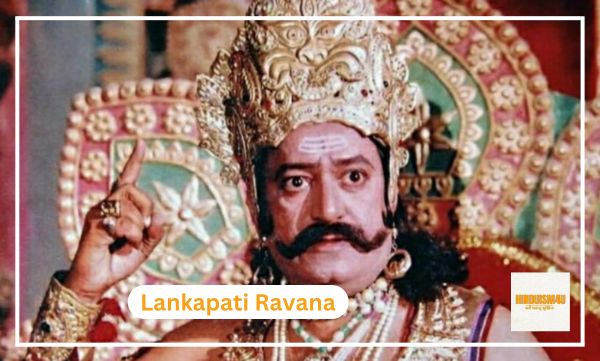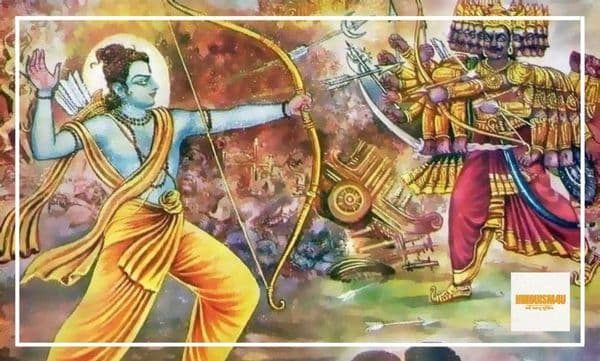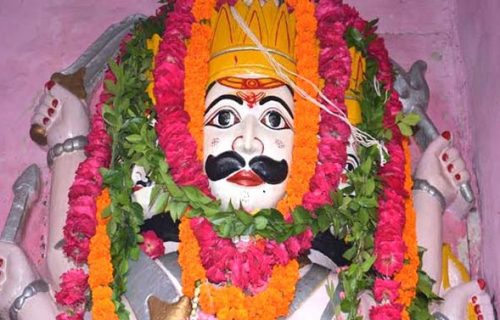Ravana who has many identities in Hinduism. When he worshiped Lord Shiva by offering ten heads to him, then he was called Dashanan. When it comes to sages, then the name of Ravana also comes and even today people consider his scholarship as iron. who conquered even the god of death and imprisoned him in his palace Lanka. Ravana conquered everyone except men and monkeys, whether they were gods or demons. That’s why he is also called Vishwavijayi in many places. He had increased his influence so much that he had kept many gods including all the Navagrahas captive.
Ravana is such a character of Hindu religion in which both faults and virtues are directly visible. Talking about his qualities, he was a knower of all the four Vedas, well versed in politics, economics, illusion, demonic power, research of weapons, etc. But in the pride of power, he made many mistakes. He started destroying religion with his powers. In the gluttony of sex, he forcefully broke the dignity of many women.

Early Life of Ravana
Meaning of Ravana
Ravana means roaring in Sanskrit language. He got this name from Lord Mahadev. According to a story, once He lifted Mount Kailash with his hands, at that time Mahadev and Mother Parvati were also on Kailash. Then Lord Shiva pressed Kailash down with his big toe, which crushed Ravana’s arms and he started crying loudly. After this, He worshiped Lord Shiva, which pleased Lord Shiva and freed him from his pain and addressed him as Ravana. After which he came to be called Ravana. Apart from this, he is addressed by many other names like – Asuraraj, Dashanan, Lankapati, Lankeshwar, Rakshasraj, Trilokvijeta etc.
Birth of Ravana
Ravana was born in Treta Yuga. Regarding the location of his birth, it is believed that He was born in Bisrakh village of Greater Noida city of present day Uttar Pradesh (India). Visarkh village was named after sage Vishwarva. According to another story, Ravana was born in Lanka itself. Ravana’s father’s name was Rishi Vishwarva. Ravana belonged to the Pulast dynasty and was one of the 10 Prajapatis. He was also the son of Lord Brahma. Apart from this, Rishi Pulast is also one of the Saptarishis. His mother’s name was Kaikashi and she was the daughter of Ravana’s maternal grandfather Sumali. Sumali was a Kshatriya demon, hence he is also called Brahmarakshasa. According to one story, Sumali wanted Kaikashi to be married to the most extraordinary person. Due to which she was married to sage Vishwarva, one of the most extraordinary persons of that time. Sage Vishwarva had 3 sons from Kaikashi. Ravana, Kumbhakaran and Vibhishana.
Education of Ravana
When Ravana grew up, he acquired spiritual and Vedic knowledge from his father and grandfather Maharishi Vishwarva and Maharishi Pulashta. Apart from this, he also received education from her maternal grandfather Sumali and maternal uncle Marich and Subahu. Apart from this, He had also taken education from Daityaguru Shukracharya. Apart from this, He had taken education from many people as per his wish and need. Ravana cannot be called a disciple of any one Guru. When Ravana grew up, he did penance to Lord Brahma and Lord Shiva and sought many powerful boons from them and after getting those boons, he appeared as the most powerful person.
Along with being a knower of all the four Vedas, Ravana was also a great knower of music, politics, economics, astrologer, Vastu, and science. He had also composed many scriptures. He had composed texts like Shivtandav Shrot, Ravana Samhita, Das Satakatika Arkaprakash, Das Patalatmika, Uddishatantra, Kumartantra, Nadi Pariksha, Arun Samhita, Ank Prakash, Indrajal, Prakrit Kamdhenu, Prakrit Lankeshwar etc.

Boon to Ravana
Ravana had earned many boons and blessings by his harsh penance. He had received boons from both Lord Shiva and Lord Brahma.
Boon received from Lord Brahma
Ravana along with his two brothers did penance on Mount Gokarna to get a boon from Lord Brahma. After about 11000 years of harsh penance, Lord Brahma was pleased with him and asked him to ask for a boon. He asked for the boon of immortality, which Lord Brahma refused to grant. Then Ravana cleverly asked for a boon to be invincible except humans and monkeys in this world and Lord Brahma granted him this boon. Same Vibhishan asked for spiritual knowledge for himself and Kumbhakaran asked for Nindrasan instead of Indrasan. It is said that when the deity came to know that Kumbhakaran wanted to ask Indrasana, he prayed to Saraswati, the goddess of Knowledge, to confuse his intelligence with your power. As a result of which Kumbhakaran asked for Nindrasan instead of Indrasan.
Boon received from Lord Shiva
Ravana also had a boon from Lord Shiva. Once He had lifted Mount Kailash with his arms and at that time both Mahadev and Mata Parvati were sitting on Kailash. Then Lord Shiva lowers Kailash with his feet, due to which Ravana’s arms get buried under Kailash. Then to get rid of that pain, he worships Lord Shiva by creating a Shivtandav shroat, which pleases Lord Shiva and asks him to ask for a boon. He asks Lord Shiva to go to Lanka after which Lord Shiva agrees to go with Ravana in the form of Linga. Although He did not take the Shivling to Lanka, at present that Shivling is located in Deoghar which is known as Vaidyanath. Apart from this, Lord Shiva also gave him a sword named Chandrahas.
Family member of Ravana
Ravan’s family structure is very rich. All his family members lived with him. Here the people related to his family are as follows:-
- Kumbhakaran – He was the younger brother of Ravana.
- Vibhishan – He was the youngest brother of Ravana.
- Surpanakha – She was the sister of Ravana. At the behest of this, Ravana made a plan to abduct Mother Sita.
- Mandodari – She was the wife of Ravana who was the daughter of the demon Maya. Mandodari was also a very virtuous woman.
- Sumali – Sumali was the maternal grandfather of Ravana. At the behest of Sumali, he performed the penance of Lord Brahma and defeated Kubera in battle.
- Malyavan – This person was the maternal grandfather of Ravana and he was also the brother of Sumali. He had forbidden Ravana to fight with Lord Rama.
- Kuber – He was the close brother of Ravana. Kuber is called the god of wealth. Ravana had snatched Pushpak Viman from Kuber.
- Meghnad – He was the most beloved son of Ravana. His mother was Mandodari and one of his names was Indrajit because he had conquered Indra as well.
- Apart from this Ravana had other sons who were known as Atikaya, Akshayakumara, Narantaka, Devantaka, Trishira, and Prahasta.
Ram Ravana Conflict
The conflict of Ravana and Lord Rama which we see as the victory of religion over unrighteousness. It begins when He comes to Panchvati to abduct Mata Sita as revenge for Surpanakha. Ravana comes in the guise of a monk and takes away Mata Janaki. After which Lord Rama reaches Lanka in search of Mother Janaki. The war between Lord Rama and Ravana in Lanka lasts for 8 days and he dies at the hands of Lord Rama. In this war, the entire clan of Ravana is destroyed, only Vibhishan survives because he leaves the side of unrighteousness and joins the side of religion, that is, Lord Ram. Tulsidas writes a very poignant thing about the Lanka war in his Ramcharitmanas – Raha na kul koi rovanhara – means there is no one left to cry on the death of Ravana’s dynasty. He was killed along with all his sons and brothers in this war.

Ravana had fought many other battles before fighting with Lord Ram. According to Ramayana, he fought with Bali in which he was defeated by Bali. He also had a fight with his own brother Kuber, in which he snatched Pushpak Vimana from him when he was victorious. Once he also had a war with Prahlad’s descendants Nivatakvachas, in which he could not win, so he made a treaty with them. In the past, he killed Anaranya, the king of Ayodhya, in a battle, in which he was cursed by Anaranya that one day he would also die at the hands of Rama. Apart from this, he also fought with King Marutta of Ushirviga, Gadhi, father of Maharishi Vishwamitra, King Dushyant, King Surath of Vidharva, King Paurav of Anga country, Chakravarti king of Dharmaranya.
Story of Jay Vijay
Through the Bhagavata Purana, we get the details of the story before Ravana. It is said that He was formerly the gatekeeper of Jai and Vijay Namak of Vaikuntha and was engaged in the service of Lord Vishnu. Once when Sanathkumar came to Vaikunth in the form of a child monk to see Lord Vishnu, Jai and Vijay did not allow them to enter Vaikunth, due to which Sanathkumar got angry and cursed both of them to be born in the land of death. When Lord Vishnu came to know about this incident, he gave two options to Jai and Vijay.
- First – Either they both become enemies of Lord Vishnu and take 3 births and Lord Vishnu will kill them in all the three births and give them salvation.
- Second – Lord Vishnu asked him to spend 7 births as a devotee of Lord Vishnu.
Both Jai and Vijay wanted to return to the service of the Lord Vishnu soon, so they sought a punishment of three births by becoming an enemy of Lord Vishnu. Later, Jai Vijay takes birth in his first birth as Hiranakashyap and Hiranyaksha in Satyuga. In the second birth they both take birth as Ravana and Kumbhakaran in Treta Yuga. In Dwapar Yuga, both of them are born as Dantavakra and Shishupala in their third birth and after getting their death at the hands of Lord Krishna, they both go back to their heavenly abode and get freedom from the cycle of human life.
Influence of Ravana
We can see the story of Ravana in Ramayana according to its creator. Ravana in Ramayana composed by Maharishi Valmiki and Ravana in Ramcharitmanas composed by Tulsidas look different. However, all the poets of ancient times or those who wrote Ramayana in modern times have also praised his qualities and talent. There is no doubt that He was an unrighteous and arrogant person, but he was also a great scholar, a great warrior, a great politician. Even today many temples of Ravana will be found in India, which worship a virtuous form of Ravana.
- Presently Brahmins of Vidisha region of Madhya Pradesh state of India worship Ravana. His temple is also found in that area where he is worshiped in a traditional way. The people of that place believe that He was a Kanyakubj Brahmin and the people there are also Kanyakubj Brahmins.
- The people of Bishrakh village (currently in the state of Uttar Pradesh, India) have similar faith towards Ravana. The people of Bisrakh village believe that Ravana was born in the same Bisrakh.
- Sachora Brahmins of Gujarat state of India also claim themselves to be descendants of Ravana and worship him. The people there often also use the surname “Ravana”. Saraswat Brahmins of Mathura also make similar claims.
- At present, the Gondi people who live in the states of Madhya Pradesh and Chhattisgarh in central India also claim themselves to be descendants of Ravana. People of Gondi caste worship Ravana along with his wife Mandodari and son Meghnad. They believe that He was the 10th Dharmaguru of their tribe and the 18th Lingo (a kind of special teacher or guru).

Author's thoughts towards Ravana
Ravana is the character of Treta Yuga and today we are living in Kali Yuga. These events take us back 2 eras from the present. We come to know about the civilization of that period through Ramayana. We currently see him as a symbol of evil which is not wrong. But are we so civilized that we are considering Ravana as a symbol of evil? Buddha had said a very great thing that only he who knows how to keep alive has the right to kill. In the same way, can we think that we consider Ravana as a symbol of evil but can we confidently say about ourselves as a symbol of goodness?
Maybe the answer is no. Because we are also filled with the same evil that was there in Ravana. Today we are full of anger, full of ego, full of jealousy towards others, the attachment towards enjoyment has crossed the limit. For their personal interest, they cross the limits of everything social, economic or moral. If we compare Ravana with today’s evil, then maybe Ravana will be better than us in many places. We burn the effigy of Ravana every year on Vijayadashami thinking that it is a symbol of the victory of good over evil. But as long as the darkness of evil is sitting within us, then we blow the effigy of Ravana, we can not even become Ravana, let alone Ram.
When Lord Ram went back to Ayodhya after killing Ravana, his mother Kaushalya asked him, Ram, how did you kill Ravana? – Lord Ram does not say that I killed Ram, he says that I did not kill the great Pratapi, Mahagyani, Mahatapaashavi Ravana, it was his ego that killed him. This civilization was in Lord Rama, the most powerful enemy of Ravana. Those who killed Ravana but also respected his qualities and ideas, gave him a great place even after his death. They did not burn the effigy of Ravana like we do every year. Maybe because people of that time were more civilized they see evil as an idealogy and not as a body.
We should also learn from them how to get rid of the evil that is being nurtured within us as a thought. Before burning the effigy of Ravana, we have to burn the evil form of darkness inside us, only then we will probably be entitled to burn the effigy of Ravana.